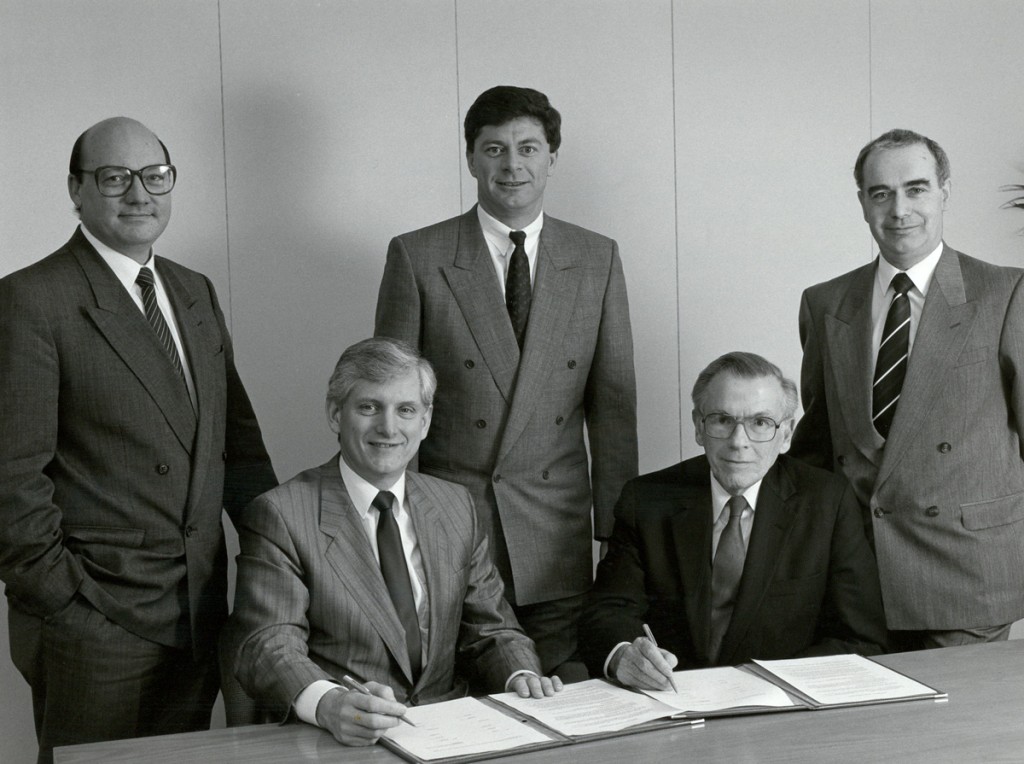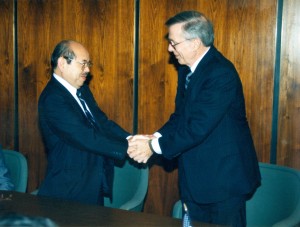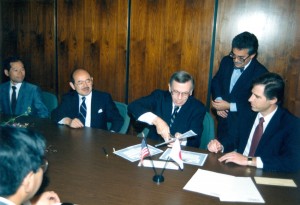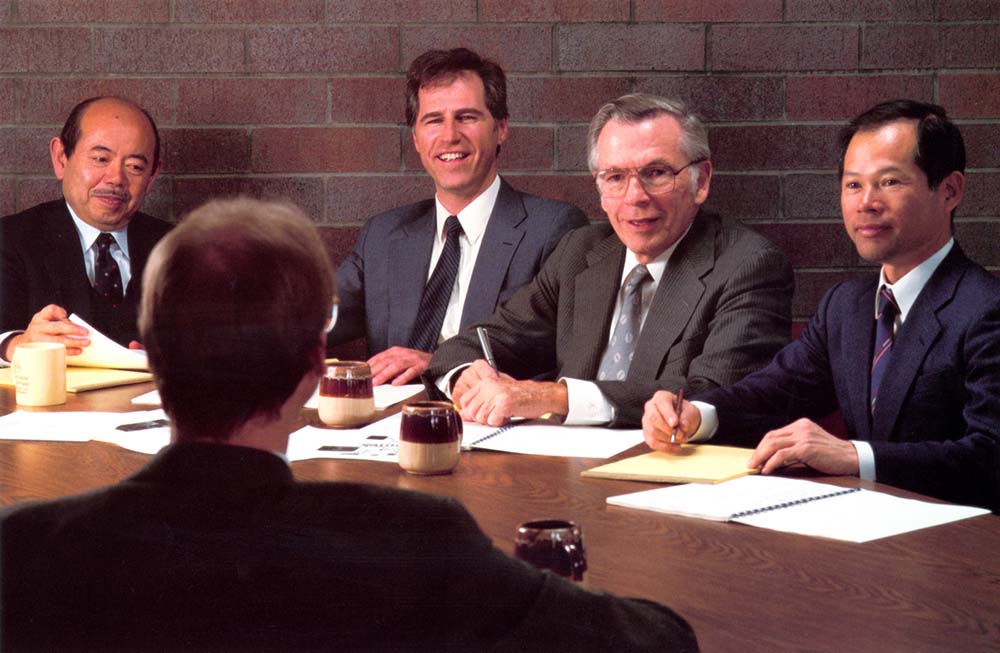In May, 1986 Dr. Petritz was approached by his Japanese friend and colleague, Mr. Makoto Watanabe with a cooperation proposal for product planning between Simtek and Nippon Telegraph and Telephone Corp (“NTT”). 1)Personal correspondence, The Petritz Collection, 1986. Mr. Watanabe had dedicated his career as a semiconductor R&D manager and senior executive at NTT from 1952-1984. In 1984 he was the acting Executive Managing Director of NTT Electronic Technology Corporation, while working as a high-level consultant to the Japanese semiconductor industry. That conversation in May 1986 resulted in discussions that lead to introductions to Nippon Steel Corporation (“NSC”), in the Autumn of 1986.
By April 1987 Dr. Watanabe had joined Nippon Steel Corp as Executive Advisor. A business plan was presented to NSC around Simtek’s proposed product line and construction of a wafer fab to be built in Colorado Springs, CO. In May 1987 an equity and license agreement was struck with NSC. Common stock was acquired by Petritz and Derbenwick and Petritz and NSC put in the first preferred stock investment of $2,250,000 into the company, giving NSC 20% of the company and a board seat.
With the initial capital infusion from NSC, Simtek had enough cash and financing promise to begin hiring and product development. With no manufacturing facility of its own, Simtek entered into a licensing deal in July 1989 with Plessey Semiconductors Ltd. (“PSL”) of England to receive technology license fees, future royalties and foundry services. The deal would give Simtek the ability to start running silicon and generate product samples for testing and early customer evaluation.
 Signing the product licensing agreement between Simtek Corp and Plessey Semiconductors, ltd Left to Right: Ray Gleason - Marketing Director, Plessey, Doug Dunn – Managing Director, Plessey, Richard Riker – VP Sales & Marketing, Simtek, Richard Petritz – Chairman & CEO, Simtek, John Brothers – Technical Representative, Plessey
Signing the product licensing agreement between Simtek Corp and Plessey Semiconductors, ltd Left to Right: Ray Gleason - Marketing Director, Plessey, Doug Dunn – Managing Director, Plessey, Richard Riker – VP Sales & Marketing, Simtek, Richard Petritz – Chairman & CEO, Simtek, John Brothers – Technical Representative, Plessey
The agreement called for joint development of new products and manufacturing processes and gave Plessey and Simtek the right to market the same products under each company’s respective name. It also gave PSL the right to incorporate Simtek’s non-volatile memory technology into its ASICs. It was less than two years before that Plessey Co. Plc had entered negotiations with Thorn to buy INMOS, but in December 1987 withdrew from the deal. Ironically, ten years before (1979) it was Plessey Semiconductors that had expressed interest in becoming a wholly-owned subsidiary of INMOS.
Touting the relationship, Doug Dunn, Managing Director of Plessey Semiconductor stated “This Agreement is a major milestone in the growth of Plessey Semiconductors” 2)“Simtek and Plessey Semiconductors Announce Strategic Alliance”, The Colorado Springs Business Journal, August 1, 1989.
. Together Petritz and Dunn optimistically placed a $30 million value on the deal over the subsequent two years 3)“Simtek Memory Tech Licensed to Plessey”, Electronic News, July 31, 1989.. The Agreement between Plessey and Simtek was phased out just a few years later.
Dunn, who had formerly worked with INMOS, went on from Plessey to become CEO of Philips Semiconductors (1993), CEO of Royal Philips Electronics (1998), CEO of ASM Lithography Holding, and a Director of STMicroelectronics, the company that had eventually took possession of INMOS assets.
While pressing forward with PSL, it remained Petritz job to continue fundraising to support ambitious business plans. In 1988 he called on Brent Nicklas a venture capitalist from New York. Petritz became associated with Mr. Nicklas in 1985, while working with Merrill Lynch Capital Markets group on a possible INMOS IPO. Co-investing together, Nicklas and Petritz continued funding Simtek through to its Initial Public Offering on NASDAQ in 1991. The public offering raised approximately $10m dollars and provided a format for successive public offerings and PIPEs (private investment in public equities) to come.
With TRW’s announcement to downsize its foundry operations, Simtek was aggressively seeking a new manufacturing source for its chips. Being Fabless, the company’s growth and profitability was heavily dependent on its foundry relationships. In 1992 Simtek entered into a manufacturing and development agreement with Chartered Semiconductor Manufacturing (CSM) of Singapore for production of 64K and 1M nvSRAMs. The agreement with Chartered was crucial for further legitimizing Simtek and its prospects.
Dr. Klaus Wiemer — an acquaintance from days past at Texas Instruments – joined the Simtek Board in 1992. Dr. Wiemer started his career at Texas Instruments and brought a deep background in semiconductor Foundry operations. He was formerly the President of Taiwan Semiconductor Manufacturing Company (“TSMC”) and was the CEO of Chartered Semiconductor from 1988 to 1991. TSMC itself was founded by Dr. Morris Chang, another associate of Dr. Petritz’s from Texas Instruments. Dr. Chang (of Chinese descent) started his career in microelectronics at TI the same year as Dr. Petritz, 1958.
Wiemer was quite familiar with Simtek before joining the Simtek board in 1992, through the Simtek and Chartered relationship. He introduced Petritz and Simtek to Zentrum Mikroelektronik Dresden AG (ZMD) in Dresden, Germany. In 1994 an agreement was signed to license Simtek’s technology and products to ZMD and to install Simtek’s 1.2 micron process in ZMD’s fab in Germany, and to jointly develop 0.8micron process technology. In 1995 it was decided to bypass 1.2 micron technology and instead concentrate on installation of the 0.8 micron technology. ZMD agreed to finance the development in exchange for shares in Simtek. That eventually made ZMD the largest single shareholder, owning approximately 30%. 4)Simtek Corp SEC K-1 and Annual Reports.
References
| ↑1 | Personal correspondence, The Petritz Collection, 1986. |
|---|---|
| ↑2 | “Simtek and Plessey Semiconductors Announce Strategic Alliance”, The Colorado Springs Business Journal, August 1, 1989. |
| ↑3 | “Simtek Memory Tech Licensed to Plessey”, Electronic News, July 31, 1989. |
| ↑4 | Simtek Corp SEC K-1 and Annual Reports. |



